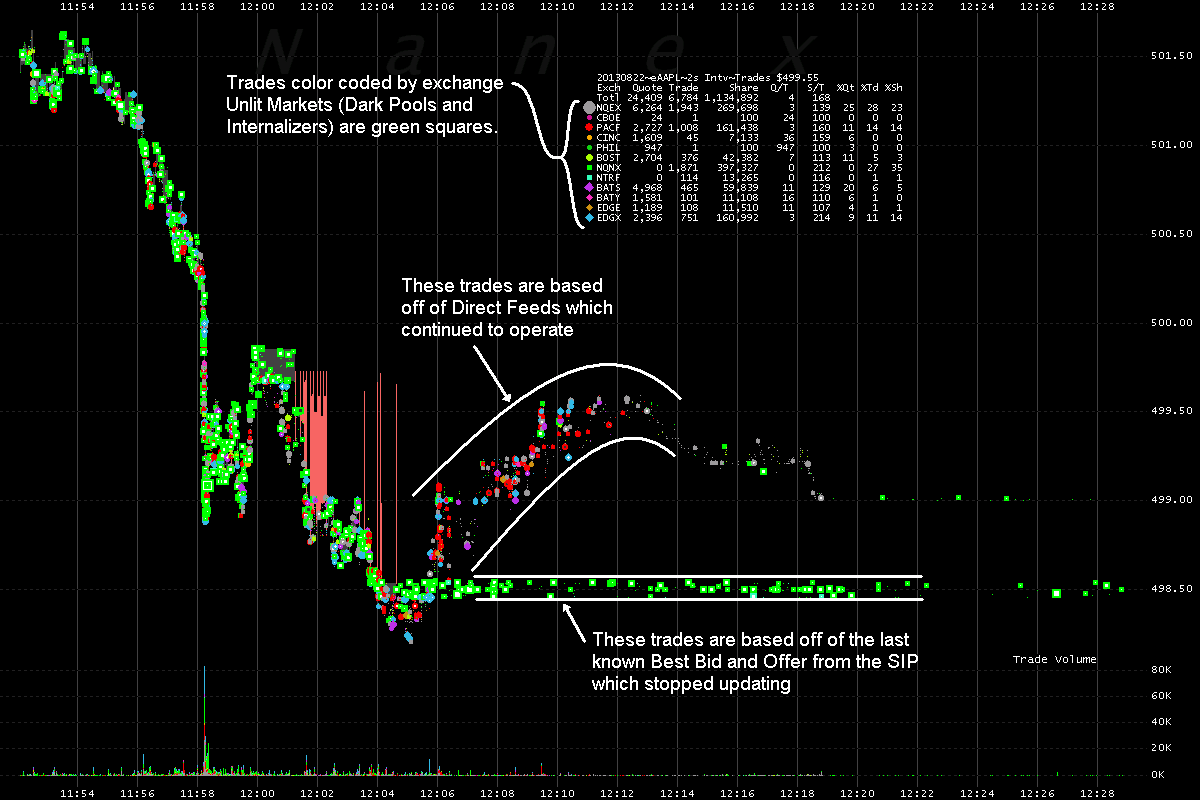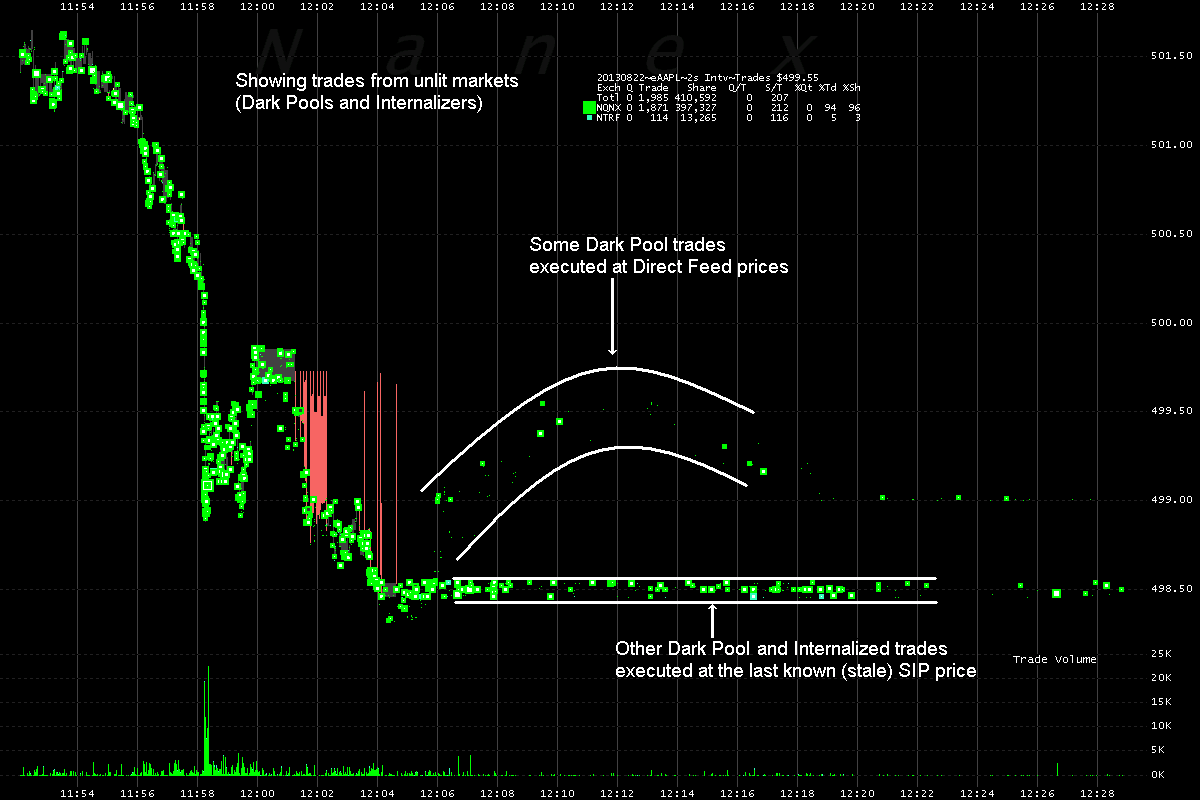Nanex Research

Nanex ~ 31-Jul-2014 ~ Retail Trades Disadvantaged by Direct Feeds
Internalizers buy at the direct feed price, sell to retail
at the SIP feed price
Executive Summary
While internalizers matching retail trades claim
they use direct feeds for pricing, there is overwhelming evidence that retail
customers, in fact, are getting prices based on the
SIP (Securities Information Processor
also known as the consolidated quote). It may be that internalizers making this claim
mean that they are using direct feed pricing for themselves to buy and sell stock on
exchanges, but they give customers prices based on the SIP. Perhaps the question to
ask the internalizers paying for retail customer order flow: what prices are you assigning
to retail customer trades?
The Setting
During the first 30 minutes of the August 22, 2013 Nasdaq black out, a curious thing
happened. SIP quotes stopped updating, but trades
continued to print in stocks for at
least another 30 minutes, and in stocks that had price
movement, two clear price bands formed: one band contained trades priced at the last known (and very stale) NBBO (National Best Bid/Offer) sent by the SIP, while the other
band contained trades priced on direct feeds that High Frequency Traders (HFT) pay exchanges princely sums for. Exchanges
can legally sell direct feeds, as long as they make trade and quote information available
to the SIP first or at the same time as direct feeds. With the SIP no longer transmitting
quotes, yet trading seemingly unaffected, it's probably a good bet that the exchanges weren't
providing the SIP with trade and quote information at the same time as the direct feeds.
While that is clearly illegal, it's something we have already
covered in detail.
The Evidence
This paper is about understanding which trades executed based on direct feed prices
and which trades executed based on the stale SIP price. While we only show prices for
the stock of Apple (symbol AAPL), many, if not all of Nasdaq stocks during the same
time present the same
evidence.
Furthermore, we have seen this phenomenon during other times (e.g. September 4, 2013, and
June 2, 2014) when the SIP had problems,
but direct feeds did not.
Note, there
are 4 main sources of trades reported to TRFs (Trade Reporting Facility,
which handle trade reporting for unlit markets):
- Retail trades, sent by internalizers, also called wholesalers. Internalizers pay brokers a fee for the
privilege of matching retail orders. The claim they provide
price improvement.
- Alternative Trading Systems (ATS), sometimes called Dark Pools. Some ATS's (Lavaflow)
publish
quotes to FINRA's ADF, but this distinction is unnecessary for
this paper.
- "Upstairs trading", or off-exchange negotiated transactions outside of a broker
dark pool, (High Touch).
- Broker internalization engines that are not registered as an ATS.
This paper focuses on retail trades executed (matched) by internalizers.
1. The SIP stops sending the NBBO in Apple stock at 12:04:40.
- Red shading indicates a crossed NBBO (Best Bid price greater than Best Offer
price) which is prohibited by Reg NMS, and often indicates a delay in
the SIP.
- There was also brief outage between 12:00:08 and 12:01:16.
- The SIP stopped sending quotes in AAPL at 12:04:40 and did not resume until 15:25:00.
- The last known NBBO was 498.45 bid and 498.53 offered.

2. A plot of the trade prices reveals two distinct bands.
- The higher priced band (in the case of AAPL, in other stocks it may be the lower
band) is from trades executed at direct feed prices. This is the true market price.
- The other band is from trades executed at of the last known SIP price. Note this second band contains only unlit markets (green squares).
- Trades at the stale SIP price are not the result of a reporting delay:
the length of time, the presence of trades in both bands, and rate of
reporting make it highly unlikely.

3. Trades from unlit markets show the same two price bands.
- This is the same chart as above, but with trades from lit markets removed.
- Some Dark Pools (such as Credit Suisse Crossfinder) use direct feeds, while
others (such as Goldman Sach's Sigma X) use the SIP.
- Even though the last quote from the SIP was at 12:04:40, trades from unlit markets continue to print
until 13:13:47 (beyond the end of this chart).

4. Retail trades execute at the last NBBO price sent by the SIP, exclusively, for
28 minutes.
To understand how we can identify retail trades,
read this page (keep following links if necessary, as this rabbit hole is deep).
- This is the same chart as above, but includes only "retail" trades.
- Even though the last quote from the SIP was at 12:04:40, retail trades continued
for 28 minutes (until 12:32:52).
- Internalizers are clearly giving retail customers prices based off of SIP data (directly
contradicting this statement made to
Congress).
- This is not an isolated incident: it is present in many stocks during the
same period of time, as well during other events when the SIP had a problem, but
direct feeds did not.

Conclusion
The evidence clearly shows that retail orders are getting prices based on the SIP, even
after the SIP stops updating for 28 minutes. Watch this
short clip which shows an internalizer telling congressmen that they use direct
feeds. Maybe the congressmen should ask - "you use direct feeds for your benefit, but
what feed do you use to assign prices to the retail
customer"?.
Nanex Research
Inquiries: pr@nanex.net




